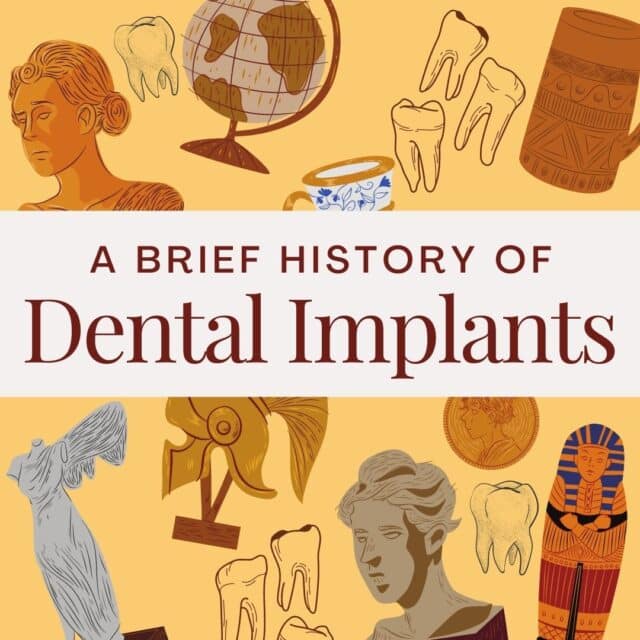The modern dental implants that we use today have come a long way over the past few decades, centuries, and yes, even millenniums. What is now regarded as the standard for tooth replacement started out with experimentation, seemingly harebrained ideas, and some not-so-sterile practices dating back thousands of years.
For as long as people have been missing teeth, there has been a need and desire to replace them. When we don’t have a healthy dentition, we can’t eat. And proper nutrition is crucial to maintaining a typical lifespan. So, as you might guess, people started out replacing teeth with all sorts of different objects just to get by. Some of them were removable—like George Washington’s dentures, which, surprisingly, were actually made out of hippopotamus ivory and real teeth, not wood—while others were implanted down into the tooth socket and gums themselves.
Earliest Types of Dental Implants
Depending on who you ask, the earliest types of dental implant treatments date back anywhere from 300BC to 2000BC. Some of the best-known early dental implant designs come from the ancient Mayan and Egyptian civilizations, but discoveries have been made in other places such as Celtic graves.
Some of the different “styles” of implant/tooth replacement included examples like:
- Seashells embedded into the jaw bone
- Gems placed into the mouth where teeth were missing
- An artificial tooth made out of iron and implanted into the jaw
- Using other human or animal teeth (it was not uncommon to purchase teeth from lower socioeconomic classes, or for them to be stolen off cadavers by grave robbers)
- Copper pegs hammered into the bone
- Bamboo pegs placed into missing tooth sockets
As you might guess, none of these examples had the potential to last for the duration we see with today’s modern implant designs. There was typically a high risk for infection or all-out rejection by the body’s immune system. And if the implant did stay put like it was supposed to, it still wasn’t as durable or as functional as a natural tooth.
Some of these tooth replacements were installed when people were living and breathing, while others are thought to have been placed postmortem as part of the burial process.
The Discovery That Changed it All
It’s impossible to talk about dental implants without mentioning a researcher from the 1950s by the name of Dr. Per-Ingvar Brånemark. Dr. Brånemark studied bone healing and regeneration, and in this case, specifically, he found that titanium materials would permanently integrate within the femur bone of a rabbit. A little over a decade later, Dr. Brånemark used a titanium appliance to replace one of his patient’s teeth. The rest is history! Dr. Brånemark lived to see significant transformations in dental implantology living until the ripe old age of 85, passing away in 2014.
Today, titanium is the predominant material used in dental implantology; it’s also used throughout medicine for surgical procedures because of how highly successful and safe it is. Not only is titanium known for promoting bone integration, but it’s also hypoallergenic and more durable than tooth enamel.
Changes in Implant Shape Over Time
Even early dental implant treatments just a few decades or more ago were extremely invasive and complex. Only certain people ever went on to try them, because of the highly involved nature of the surgical process. Installation and recovery were lengthy, and the implant device itself wasn’t nearly as minimalist as today’s are. Oftentimes, they featured a large blade or mesh device that had to be placed on top of or inside of the jawbone, distributing wide amounts of pressure throughout the mandible.
Thankfully, it didn’t take very long for things to change. With a greater understanding of biocompatible materials, tooth anatomy, and bone integration, dental implants began taking on a more lifelike, anatomical tooth shape. Even the more complex full-arch cases transformed into minimalistic prosthetics that were more predictable and comfortable to install, offering a permanent solution for oral rehabilitation.
Today, dental implants are the next best thing to natural teeth. They take up the same amount of space, rest directly alongside other teeth in your mouth, and function identical to the rest of your smile.
Dental Implants Offer More Options Than Ever
In the past few decades alone, modern implants have evolved from an experimental, rarely-performed procedure that wasn’t covered by dental insurance into an everyday, predictable treatment for people with missing teeth.
From single tooth replacement to full-arch hybrid appliances like All-on-4, implants set the bar for oral function, aesthetics, and wellness. They’re more predictable than any other dental restoration (including fillings and crowns) and outlast every single one of them. All you have to do is take care of them like you would your natural smile.
Even if you’ve been told in the past that you don’t qualify for dental implants, that may not actually be the case anymore. Especially when you’re working with a team of specialists like the ones at ARCHPOINT. With advanced techniques, technology, and expert care, more patients qualify for dental implants than they ever have before.
Best of all, you don’t necessarily need an implant for every tooth that’s missing. We can pair them together for 3 or 4-unit dental bridges so that you don’t need to wear a partial denture. Or when you want to anchor a full-arch prosthesis, only 4-6 implants are required instead of 14! They truly offer the best return on investment of any traditional or modern tooth replacement alternative.
Dental Implant Treatment in Ft. Worth, Dallas
ARCHPOINT Implant Dentistry brings board-certified specialists and expert implant providers together into one location. There are no back-and-forth referrals necessary when you need to rebuild your smile. Everything—from tooth removal and sedation to implant installation and placement of your prosthesis—is completed under one roof. By developing relationships with our patients and valuing high-level communication, we can ensure a relaxing and predictable process for all of our clients.
To find out more about dental implants in DFW and learn if they’re right for you, contact ARCHPOINT today. Flexible payment options are available, so there’s no need to wait another moment. Call now!








